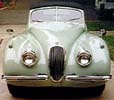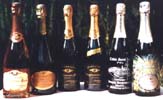



You are here: Home
   |

|
|
You are here: Home |
The calculator (and other electronic devices) in the kitchenI keep my Dad?s old Casio scientific calculator in a drawer in my kitchen. Since that corner of the kitchen is where a lot of domestic paperwork is done, that?s not altogether surprising. But I do occasionally use the calculator when cooking. Most times, when you change the quantities in a recipe, it?s simply a case of halving or doubling them, but there are odd occasions when you might need to do some slightly more sophisticated arithmetic. Take meringue, for example. My fridge accumulates egg-whites because I make rather a lot of tiramisù, crème brûlée, crème Patissière and other notorious cholesterol-boosters. When I become embarrassed by the quantity of egg-whites in the fridge, I make meringue. The trouble is that the egg-whites don?t accumulate singly so that I can count them. They collect in a puddle in a pudding basin. So how in Heaven?s name do I turn this puddle reliably into meringue? The admirable Roux Brothers on Patisserie is my bible for things sweet and sticky. It contains no less than four recipes for meringue - Swiss, French and Italian - and ?a more sophisticated mixture? called Fonds de Progrès aux Amandes ou Noisettes (almond or hazelnut meringues ?Japonais?). Helpfully, the first recipe starts with the entry ?4 egg whites (125 ml/4 fl oz or 40 g/4½ oz)?. Even my mental arithmetic can extract from this the useful information that, for the Roux brothers at least, one egg-white has a volume of 31.6666666 ml or one fluid ounce (one of those rare examples where the Imperial system wins hands-down over metric). Alternatively - and more usefully, as you?ll know if you?ve ever tried to measure an exact volume of egg-white - one white weighs 10 grams or one and one-eighth ounce. Years of proofreading has taught me never to assume that what is in print is necessarily accurate. When I started using this crucial information, something nagged at the back of my mind. I wasn?t sure just how many grams made an ounce, but I was pretty sure it was a lot more than 10. A quick check with my science encyclopaedia told me it was actually 28.4. The entry should read ?125 g/4½ oz? and one white therefore weighs 30 grams, as near as makes no difference. So, back to the calculator... However thoroughly you separate eggs, some white always stays with the yolk. (Provided it isn?t too much - because white sets much more quickly than yolk when cooked - this doesn?t matter. It?s far more important that no yolk stays with the white: if it does, you?ll never be able to beat the whites stiffly.) It follows that even if your eggs were absolutely standard, with exactly 30 grams of white each, your accumulated bowl of whites won?t weigh an exact multiple of 30 grams. At this point another useful electronic device comes into play - my digital kitchen scale, on which I can use anything from a bit of kitchen foil to a small bucket as a scale pan. I put the bowl I?m going to beat the eggs in on the scales, press the ON button and wait for the display to show zero. This machine starts in grams and has a button to press if you want to work in pounds and ounces. I tip the bowl of whites in and the display reads 142 grams. My recipe (corrected for the error) calls for 125 grams of white and 300 grams of sugar. The calculation to find the right amount of sugar for 142 grams is simple - provided you have an electronic calculator: (the original quantity of sugar divided by the original quantity of egg-white and multiplied by the new quantity of egg-white). So I press the ON button on the scales again to zero the display and pour in sugar until I have 340 grams. Now I can make my odd quantity of Swiss meringue and use up all my egg-whites. The general rule I applied in this specific case, for non-mathematicians, is this: if you are ?downsizing? (as they say in modern management) or (presumably) ?upsizing? a recipe because you have a different quantity of a key ingredient, you:
Whipping-up some whipping creamAnother invaluable bit of information in the same wonderful book is tucked away in the recipe for Crème Chantilly: ?If you haven?t any whipping cream, but only double cream, add some very cold milk to the cream before whipping. You will need 15 percent of the volume of the cream...? This is a bit more complicated, because if you want to end up with a specific quantity of whipping cream you have to calculate both how much double cream and how much milk you need. Here goes... You?re adding milk equal to 15% of the volume of double cream, so you?re going to end up with 115% of that volume. So what percentage of the mixture is milk? To calculate what percentage 15 is of 115, we do this: We can ignore 0.04, so whipping cream is made by mixing 13% milk with 100 - 13 = 87% of double cream. Let?s say we have a recipe that asks for a really inconvenient quantity of whipping cream - say 465 ml. The calculation to found the amount of milk is: So pour 60 ml of milk into your measure, top up with double cream to 465 ml, stir - and you have your whipping cream. Simple. The digital scalesI?ve already mentioned this recent addition to my kitchen armoury, and the fact that pressing the ON button resets the display to zero. This is marvellous when assembling the ingredients for a complicated recipe, because you can weigh all the ingredients into the one bowl as you mix. For example, when making a simple pastry that requires the butter to be rubbed into the flour, I simply put my mixing bowl on the scales and switch on, then sift in flour until I have the right amount. Then I press the ON button to zero the display and cut bits of butter in until I have the right amount again. I then take the bowl off the scales, rub in the butter, return the bowl to the scales, press the ON button again, weigh in the sugar - and so on. The only shortcoming is the battery-saving ?auto-OFF? function, which occasionally switches the scale off when, for instance, I?ve gone over to the fridge for another packet of butter. Manufacturers, please note! |
Personal site for Paul Marsden: frustrated writer; experimental cook and all-round foodie; amateur wine-importer; former copywriter and press-officer; former teacher, teacher-trainer, educational software developer and documenter; still a professional web-developer but mostly retired. This site was transferred in June 2005 to the Sites4Doctors Site Management System, and has been developed and maintained there ever since. 
|
|